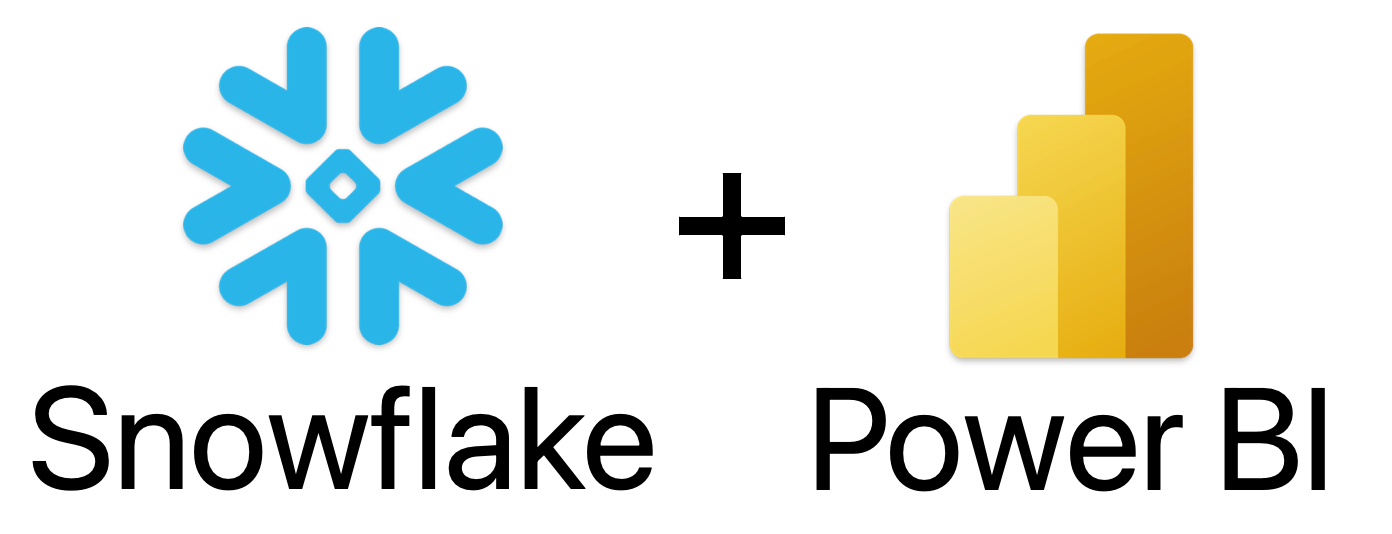PowerBI and Snowflake Integration
This blog will explore how to effectively integrate Power BI with Snowflake, focusing on best practices and technical details from the provided documents. It aims to help users understand the process and optimize their data analytics workflows.

Best Practices for Integrating Power BI with Snowflake
Introduction
Power BI and Snowflake are powerful tools for data analytics and warehousing, respectively. Integrating them can enhance your ability to analyze large datasets efficiently. This blog, based on provided training materials and best practices, will guide you through the process and optimization strategies.
Power BI is a business analytics tool by Microsoft that provides interactive visualizations and business intelligence capabilities. It consists of three main components: Power Query for data transformation, Analysis Services for data modeling, and Reporting for visualizations. Snowflake, on the other hand, is a cloud-based data warehousing platform that enables organizations to store, process, and analyze large volumes of data efficiently, with a unique architecture separating storage and compute for flexible scaling and cost management.
Integrating these platforms allows for seamless data analysis, leveraging Snowflake’s scalability with Power BI’s visualization capabilities. This blog will cover the integration process, including provisioning, authentication, and connectivity, followed by best practices to ensure optimal performance.
What is Power BI?
Power BI is not just a reporting tool; it has three main components:
- Power Query: A UI for basic transformations like joining, filtering, and pivoting data.
- Analysis Services: Handles data modeling, supporting in-memory, direct query, or both modes.
- Reporting: The visualization layer, creating visuals on top of the model.
The modeling layer significantly impacts how Power BI consumes Snowflake data, affecting both performance and efficiency.
Licensing and Deployment Options
Power BI Licensing Matrix
| Tier | Cost | Key Capabilities | Best For |
|---|---|---|---|
| Desktop | Free | • Local report creation • Ad-hoc data exploration | Individual analysts |
| Pro | $10/month | • Collaboration • Dashboard sharing • Report publishing | Small teams |
| Premium Per User (PPU) | $20/month | • Advanced features • Enhanced performance | Mid-sized organizations |
| Premium Capacity | $5k-$10k/month | • Large-scale data processing • Enterprise-grade performance • Unlimited content distribution | Large enterprises |
| Embedded | Variable | • Integrated analytics • White-label reporting | ISVs and application developers |
What is Snowflake?
Snowflake is a cloud-based data warehousing platform that allows organizations to store, process, and analyze large volumes of data efficiently. It offers a unique architecture that separates storage and compute, enabling flexible scaling and cost management. It supports structured and semi-structured data, operates on major cloud providers like AWS, Azure, and Google Cloud, and is designed for high concurrency and performance.
Snowflake offers:
- Unlimited scalability
- Separation of compute and storage
- Zero-maintenance data infrastructure
- Advanced security features
- Cross-cloud capabilities
Integrating Power BI with Snowflake
Connector Types
Power BI offers two main connection types for interacting with Snowflake:
- Native PowerBI Snowflake Connection: A direct, optimized connection designed specifically for Snowflake, supporting both Direct Query and Import Query modes.
- ODBC Connection: A general connection using ODBC drivers, also supporting Direct Query and Import Query modes.
Both connections support various authentication types, including Single Sign-On (SSO), Password, and Key-Pair, and features like Select Role and Custom SQL. Notably, Snowflake customers incur no cross-region or cross-cloud egress data transfer charges using either option, which can be a significant cost-saving factor.
| Engine | Access | Native PowerBI Snowflake Connection | ODBC Connection |
|---|---|---|---|
| Query Type | Auth Type | ||
| Direct Query | Import Query | ||
| ————————– | ————————– | ————– | ————– |
| Power BI Desktop | Public | ✓ | ✓ |
| PrivateLink | ✓ | ✓ | |
| Power BI Service | Public + Gateway | ✓ | ✓ |
| PrivateLink + Gateway | ✓ | ✓ | |
| Power BI Report Server | Public | ✓ | ✓ |
| PrivateLink | ✓ | ✓ |
Storage Modes Explained
1. Import Mode
- Complete data transfer to Power BI
- In-memory processing
- Pros:
- Extremely fast performance
- Full Power BI functionality
- Cons:
- 1GB data limit (Pro license)
- Requires manual refreshes
2. DirectQuery Mode
- Real-time querying from Snowflake
- Pros:
- No data volume restrictions
- Always current data
- Cons:
- Potential performance issues
- Limited Power BI features
3. Composite Models
- Hybrid approach
- Dimension tables: Import mode
- Fact tables: DirectQuery mode
- Optimal for complex data scenarios
4.Dual Mode**: Allows tables to act as both Import and DirectQuery based on query context, balancing performance and data freshness.
Model types include:
- Composite Models: Allow mixing Import and DirectQuery modes within the same model, ideal for importing dimensions for fast filters and keeping large fact tables in DirectQuery mode.
- Best practice: Use Import mode for dimension tables and DirectQuery for large fact tables, especially those with low SLAs, to optimize performance.
| Feature | Import | DirectQuery |
|---|---|---|
| Size | Up to 1 GB per dataset (Pro license) | No limitation |
| Data Source Support | Can import data from multiple sources | Data must come from a single source (e.g., Snowflake) |
| Performance | High-performance query engine | Depends on network connectivity and data source speed; only metadata and schema stored in the model |
Performance Optimization Techniques
Data Modeling Best Practices
-
Star Schema Design
- Organize data into fact and dimension tables
- Minimize data redundancy
- Optimize query performance
-
Preprocessing in Snowflake
- Perform complex transformations upstream
- Reduce Power BI processing overhead
Provisioning and Authentication
Connector Types
-
Native Snowflake Connector
- Direct integration
- Multiple authentication methods:
- SSO (Single Sign-On)
- Password
- Key-pair authentication
-
Authentication Options
- Public cloud connections
- PrivateLink environments
- On-premises data gateways
Integrating Power BI with Snowflake involves setting up user provisioning and authentication:
- User Provisioning Using SCIM: Automate user and role creation from Azure AD to Snowflake using SCIM. Steps include creating a SCIM integration in Snowflake, setting up users in Azure AD, assigning them to the Snowflake application, configuring provisioning, and verifying the setup. This ensures centralized management and automation, though SCIM does not support Private Link and uses public connectivity.
- Authentication: Supports Username/Password (Basic Authentication) and SSO via OAuth with Azure AD. For SSO, obtain the Tenant ID from Azure AD, create an external OAuth integration in Snowflake, and configure Power BI for SSO, ensuring users are redirected to sign in with Azure AD credentials.
Authentication Methods
-
Single Sign-On (SSO)
- User-level security granularity
- Seamless authentication
- Inherit Snowflake security policies
-
Role-Based Access Control
- Implement secondary roles
- Limit data access privileges
- Use
DEFAULT_SECONDARY_ROLES
Connectivity Patterns
Connectivity can be public or private:
- Public Connectivity: Uses standard internet connectivity with TLS 1.2 encryption, suitable for initial setups.
- Private Connectivity: Utilizes Azure Private Link for secure access over private IP addresses, requiring setup of Private Link endpoints and DNS zones in Azure, and updating Power BI to use Private Link URLs.
Storage Modes and Composite Models
- Use Composite Models appropriately, with Import mode for dimension tables (fast filters and slicers) and DirectQuery mode for large fact tables.
- Leverage Dual mode for dimension tables when possible, allowing Power BI to switch between Import and DirectQuery based on query context.
- Use Power BI’s hybrid tables feature for Incremental Refresh, enabling a single table to use both modes for different partitions.
Network and Location Considerations
- Minimize network latency and bandwidth issues by ensuring the Power BI tenant or Premium capacity is located in the same Azure region as the Snowflake account.
- For Power BI Premium, utilize the multi-geo capacity feature to store data in different Azure regions if needed.
Gateway Usage
- Use On-Premises Data Gateways for private data sources (e.g., within a VNet, Private Link, or behind a corporate firewall), requiring management for updates and patches, and can be clustered for high availability.
- Use VNet Data Gateways for data sources on Azure within a VNet, managed services injected into a dedicated subnet, supporting clustering, and in preview, requiring Premium licenses.
Concurrency and Parallelism
- Adjust the “Maximum connections per data source” property (default 10, up to 30 with Premium) to improve performance, especially for reports with many visuals or slow queries. Test in Power BI Service, not just Desktop, as performance may differ.
- Connecting via On-Premises or VNet Data Gateways can increase parallelism, enhancing performance. Gateways adjust settings based on CPU capacity, with some manual tuning possible.
- For VNet gateways, create high-availability clusters to load balance requests, with each gateway supporting six concurrent queries.
- For Power BI Premium, adjust workload settings like “Max intermediate rowset count” for DirectQuery mode, but focus on remodeling data or rewriting DAX rather than increasing limits.
- Use Horizontal Fusion (available for Gen2 workspaces) to combine similar-shaped queries into a single, complex query, reducing round trips to Snowflake and improving performance. This must be manually enabled in Power BI Desktop.
- Implement Query Parallelization to reduce “chattiness” by issuing queries in parallel instead of sequentially, improving performance for operations like time intelligence measures or multi-fact table visuals.
Query Performance and Optimization
- Use aggregations in Power BI (stored in Import or DirectQuery mode) to improve query performance. Test against Snowflake materialized views to determine the best approach, noting that automatic aggregations are unavailable with SSO.
- Limit the number of visuals on report pages to minimize DAX and SQL queries, enhancing readability and performance.
- Use Query Reduction options, especially for slicers, to apply filters only when the “Apply” button is used, reducing unnecessary queries.
- Enable “Assume referential integrity” in DirectQuery mode to force inner joins instead of left outer joins, speeding up queries if data quality is reliable.
- Use bi-directional filters cautiously, as they increase query complexity and should be reserved for specific cases like one-to-one or many-to-many relationships.
- Minimize dataset size by including only necessary tables and columns, removing unnecessary ones to reduce memory usage and improve performance.
- Scope user roles to limit access to 10,000 objects or fewer to speed up metadata calls during initial data loads.
- Avoid using custom SQL queries as data sources; instead, use tables or views from Snowflake for better maintainability and performance.
Warehouse and Caching
- Use a dedicated Snowflake warehouse for Power BI queries, sized appropriately, and avoid quick suspension to preserve the data cache.
- Configure warehouse auto-scaling for high-concurrency scenarios and use materialized views and the Snowflake Search Optimization Service for better query performance.
- Ensure result caching is enabled, as Power BI frequently runs the same queries against Snowflake.
- Set columns as non-nullable if they never contain null values to simplify SQL generation.
Conclusion
Integrating Power BI with Snowflake offers powerful analytics capabilities, and following the outlined best practices ensures optimal performance, security, and efficiency. By leveraging the provided training materials, users can set up robust integrations and maintain high-performing data workflows.
Additional Resources
For further reading, refer to the official documentation at Snowflake Documentation and Power BI Documentation.
